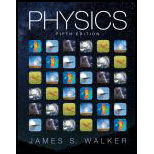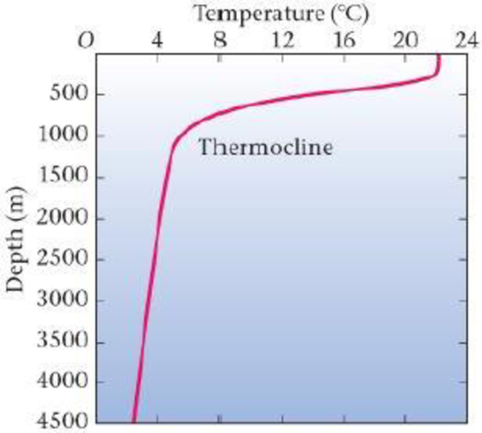
Energy from me Ocean
Whenever two objects are at different temperatures, thermal energy can be extracted with a

Figure 18-37 Temperature versus depth for ocean waters in the tropics (Problems 93, 94. 95. and 96)
The idea of tapping this potential source of energy has been around for a long time. In 1870, for example, Captain Nemo in Jules Verne’s Twenty Thousand Leagues Under the Sea, said, “I owe all to the ocean; it produces electricity, and electricity gives heat, light, motion, and, in a word, life to the Nautilus.” Just 11 years later, the French physicist Jacques Arsene d’Arsonval proposed a practical system referred to as Ocean Thermal Energy Conversion (OTEC), and in 1930 Georges Claude, one of d’Arsonval’s students, built and operated the first experimental OTEC system off the coast of Cuba.
OTEC systems which are potentially low-cost and carbon neutral, can provide not only electricity, but also desalinated water as part of the process. In fact, an OTEC plant generating 2 MW of electricity is expected to produce over 14,000 cubic feet of desalinated water a day. The governments of Hawaii, Japan, and Australia are actively pursuing plans for OTEC systems.
96. •• A commercial OTEC system may take in 1500 kg of water per second at 22 °C and cool it to 4.0 °C. How much energy is released in one second by this system? (For comparison, the energy released in burning a gallon of gasoline is 1.3 × 108 J .)
- A. 2.5 × 107 J
- B. 1.1 × 108 J
- C. 1.4 × 108 J
- D. l.6 × 108 J
Want to see the full answer?
Check out a sample textbook solution
Chapter 18 Solutions
Physics (5th Edition)
Additional Science Textbook Solutions
Chemistry: The Central Science (14th Edition)
Human Biology: Concepts and Current Issues (8th Edition)
Campbell Biology (11th Edition)
Microbiology with Diseases by Body System (5th Edition)
Campbell Essential Biology with Physiology (5th Edition)
College Physics: A Strategic Approach (3rd Edition)
- A capacitor with a capacitance of C = 5.95×10−5 F is charged by connecting it to a 12.5 −V battery. The capacitor is then disconnected from the battery and connected across an inductor with an inductance of L = 1.55 H . At the time 2.35×10−2 s after the connection to the inductor is made, what is the current in the inductor? At that time, how much electrical energy is stored in the inductor?arrow_forwardCan someone help me with this question. Thanks.arrow_forwardCan someone help me with this question. Thanks.arrow_forward
 College PhysicsPhysicsISBN:9781938168000Author:Paul Peter Urone, Roger HinrichsPublisher:OpenStax College
College PhysicsPhysicsISBN:9781938168000Author:Paul Peter Urone, Roger HinrichsPublisher:OpenStax College College PhysicsPhysicsISBN:9781285737027Author:Raymond A. Serway, Chris VuillePublisher:Cengage Learning
College PhysicsPhysicsISBN:9781285737027Author:Raymond A. Serway, Chris VuillePublisher:Cengage Learning Physics for Scientists and Engineers: Foundations...PhysicsISBN:9781133939146Author:Katz, Debora M.Publisher:Cengage Learning
Physics for Scientists and Engineers: Foundations...PhysicsISBN:9781133939146Author:Katz, Debora M.Publisher:Cengage Learning
 Physics for Scientists and Engineers, Technology ...PhysicsISBN:9781305116399Author:Raymond A. Serway, John W. JewettPublisher:Cengage Learning
Physics for Scientists and Engineers, Technology ...PhysicsISBN:9781305116399Author:Raymond A. Serway, John W. JewettPublisher:Cengage Learning





